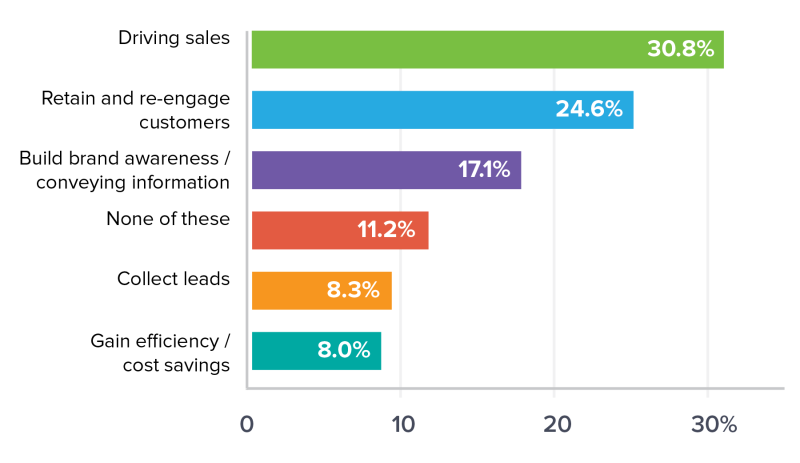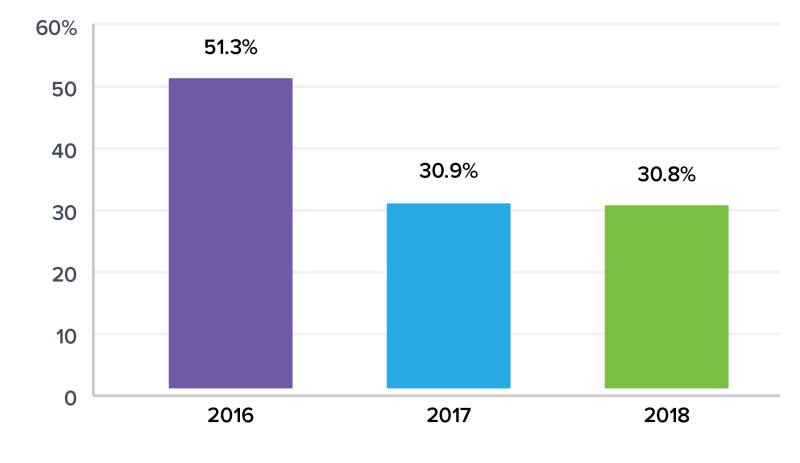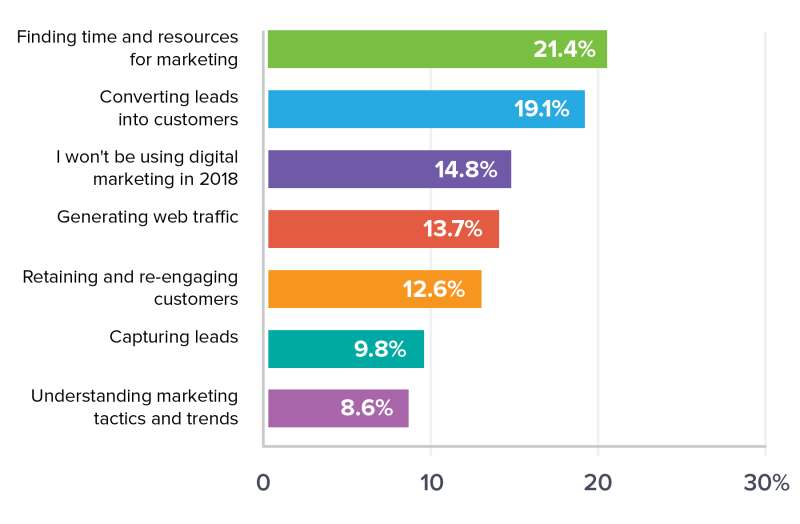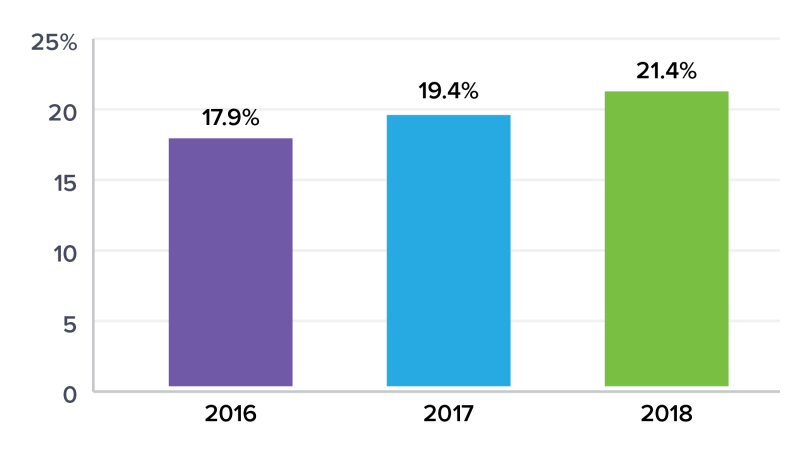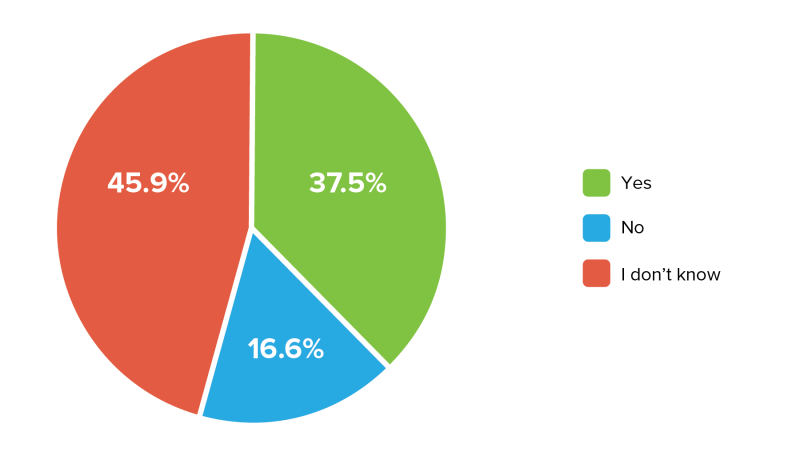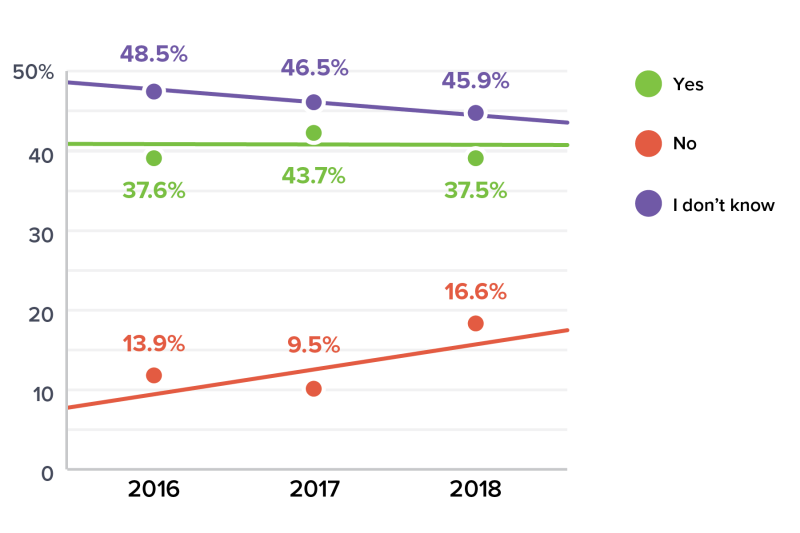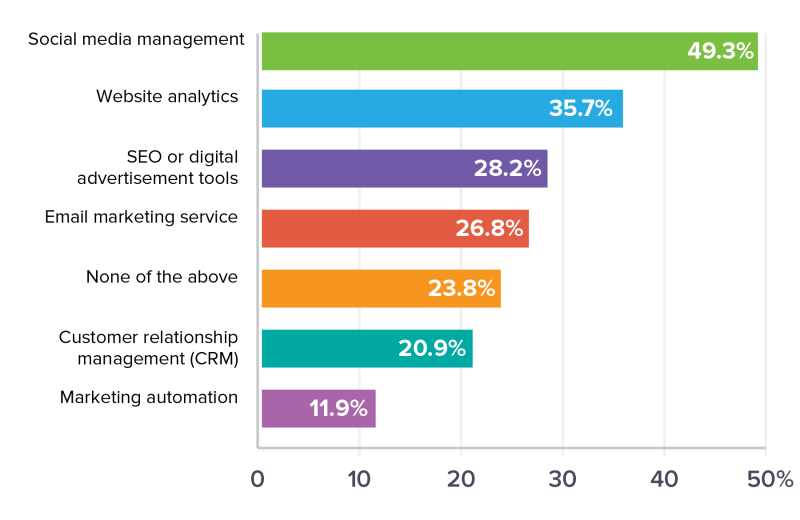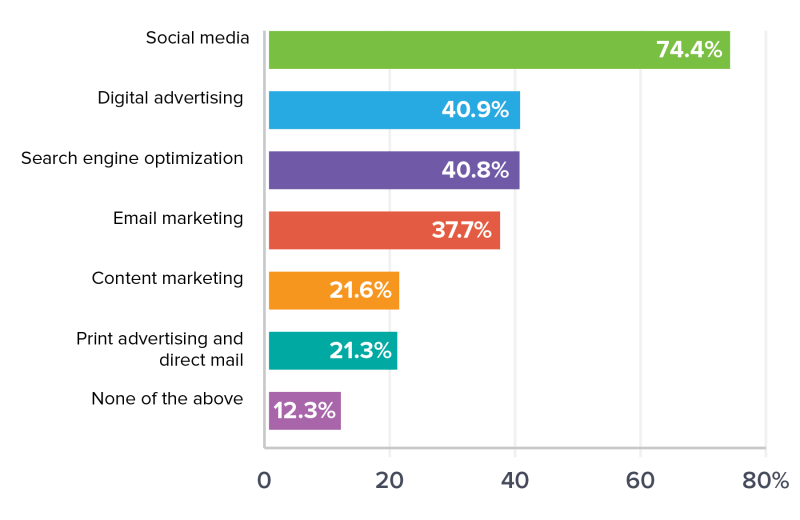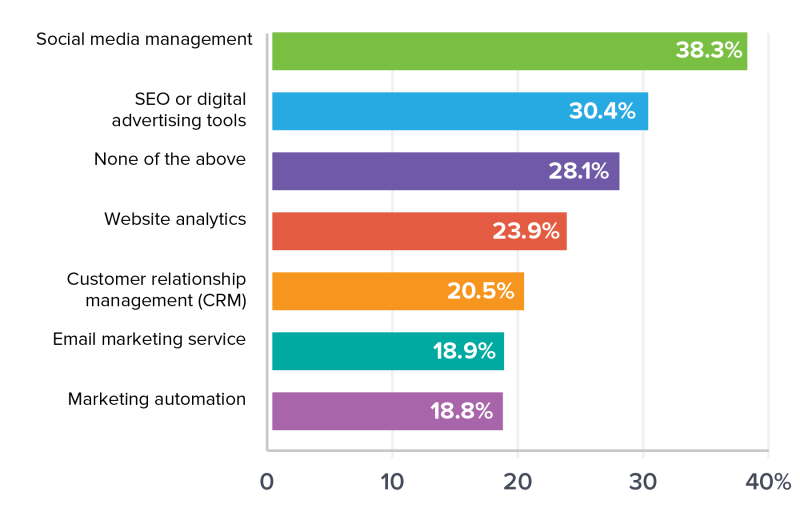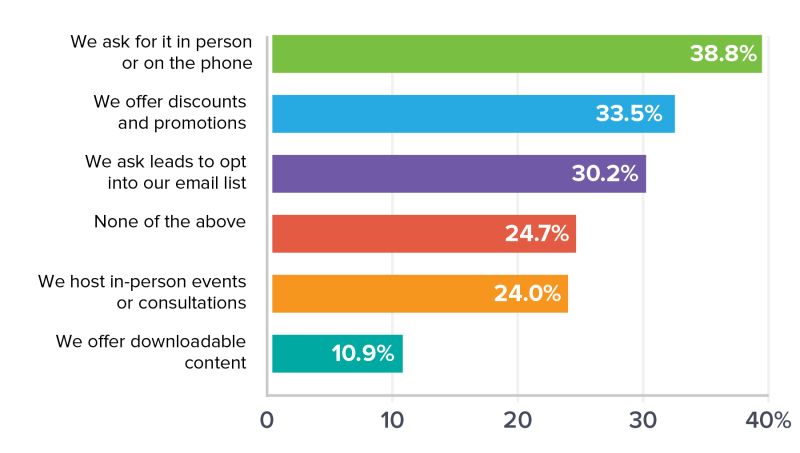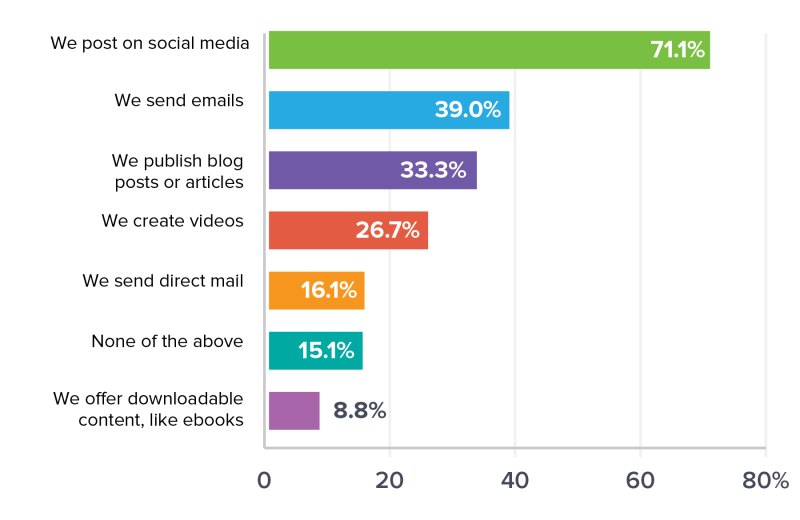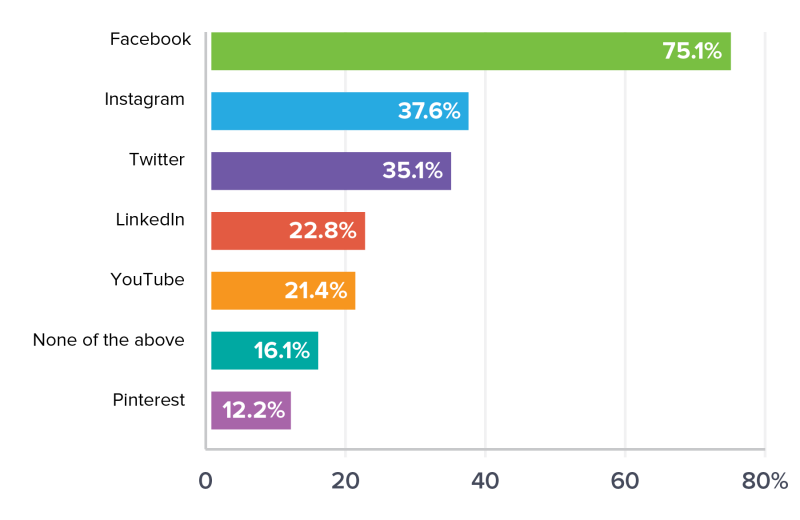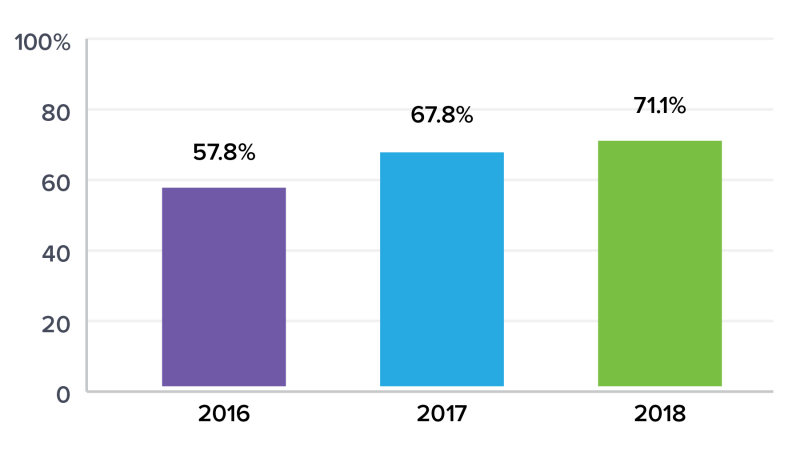Small businesses may struggle with finding time, but that only means they need to get clear on what to prioritize. The world of marketing technology is changing rapidly, and while many systems add efficiency, this can add system chaos that ends up creating an unanticipated collateral impact on time and effort.
We talked to top brands and marketing experts to see what small business owners should do in 2018 to maximize their marketing success.
Growth will come from connecting social media to other marketing tools — Zapier
Social media continues to be a dominant source of new leads and sales, as was the case last year. Tools like Facebook Lead Ads and LinkedIn Lead Gen Forms (which launched in the spring of 2017) continue to grow rapidly as they enable high-volume lead acquisition from two of the most popular social media networks—less friction means more submissions.
From there, we see massive growth for SMBs to create customized, targeted social media marketing campaigns by connecting Facebook Lead Ads and LinkedIn Lead Gen Forms to their other marketing tools. With Zapier, for example, companies can create workflows that automatically populate CRMs like Keap and mailing lists from these ads and landing pages. Zapier provides integrations between 900-plus apps, and we see SMB-driven marketing processes swelling on a huge scale in the past year. Case in point: Facebook Lead Ads and LinkedIn Lead Gen Forms are at the top of fastest growing apps on Zapier for 2017.
Ease of access to automation is key in the above dynamic, as we've noticed a strong boost to capacity and efficiency when processes flow through connected apps, cutting out wasted manual effort for staff and maximizing response time.
To provide a sense of scale, EMarketer estimated that mobile advertising budgets will hit $158.55 billion by 2018 and that at this time mobile ad budgets will be more than 50 percent of all worldwide digital advertising. The new social media ad platforms are optimized for mobile, where consumers and buyers are most likely to interact with social media.
Bot platforms for social media are also an increasing presence, allowing SMBs to offer personalized engagement at scale without needing to ramp up, and the prevalence of integrations with these allows for monitoring at every step.
We're also noticing increased concern for data-driven optimization, leading to the use of tools like Facebook Offline Conversions or Google Analytics to track examples of the marketing that works and use it to continually refine audiences.
When it comes to communication and content, we're seeing similar trends, like Hootsuite's release of an API, allowing SMBs to pipe out in regular streams of content with automated ease and frequency.
In all of these, we notice a larger trend: the empowerment of the SMB. Tools that help with every part of the marketing funnel, from getting new leads to engaging them and closing the deal, are accessible, easy to use, affordable, and often require minimal technical skill.
These direct-to-consumer tools allow small businesses to execute and iterate on their marketing quickly, effectively, and within budget. Content is being generated, queued, and disseminated automatically. Leads are copied through to all the key apps businesses use to track and communicate with leads. Conversions can be intelligently and instantly fed back into the same systems that acquired new users, creating an ever increasing positive feedback loop.
Above all else, we encourage every SMB to start thinking about how they can leverage technology for more intimate relationships with clients, with honest, personalized engagement and fast responses. Connect your tools, cut manual and wasted effort, set up automated response and engagement, and use all that free time to dig into what your clients truly empathize with.
The future is Facebook — Mari Smith
Mari Smith—one of the world’s leading social media thought leaders, widely recognized for her Facebook marketing expertise, and author of The New Relationship Marketing and coauthor of Facebook Marketing: An Hour A Day—joined us for a webinar event in November. The webinar takes a deep look at Facebook’s strategy for the next several years and offers powerful, yet practical, insight for small businesses who want to make the most of that platform.
Smith provides three important takeaways that small businesses using Facebook need to keep in mind in 2018.
“What you need to know now as a marketer, as a business owner, to really take advantage of what Facebook is rolling out in the coming 12 to 18 months,” she said, is “how the world is communicating: it is mobile, mobile, mobile.” Nearly 90 percent of Facebook users access the platform predominantly on their mobile device. She noted that the average consumer spends five hours a day on their mobile devices, and one solid hour of that time is spent solely on Facebook—that’s 20 percent of their total time on mobile. And a further half hour of that time, 10 percent of all their time on mobile, is spent on messaging apps, like Facebook’s Messenger. This means anyone using Facebook absolutely must keep mobile in mind.
Any ads you create on Facebook need to be mobile conscious. Think about how mobile users interact with the content. Think “Thumb-stopping creative;” in other words, what will catch a user’s eye enough to halt her scrolling. This means short, catchy, and creative content works. Smith noted that Buzzsumo recommends that you limit your text content to 84 characters on average (61 characters is the median) for the most success. “Now I have to tell you,” she went on to say, “I tend to be a little more wordy than 84 characters...but I’ve done that for 10 years on my Facebook page, and my audience is used to that. I want to encourage you to test, test, test, and find out what works for you.”
Video is even more powerful than ever, and small businesses can’t ignore this. Smith referred to a recent eye-tracking study that found people gaze five times longer at video than static content on Facebook and Instagram. Smith pointed to five factors to the rise of video identified by Facebook:
- The rise of smartphones makes it easier to consume video
- Audiences have shorter attention spans and want micro-videos (videos 10-30 seconds in length)
- Binge watching—Facebook launched Watch, their streaming television app. Streaming TV is a massive market, and it’s skyrocketing
- Video in your social stream is contextualized and highly relevant to your interests
- Novelty—Facebook’s latest product, Watch is new, drawing the attention it needs to move aggressively into the streaming television market
Thirdly, Smith noted that we are in the age of conversational commerce. At the center of this is messaging apps. You need only look at what’s happening with China’s WeChat platform to see where the future of Facebook’s Messenger is headed. “It has been said, my friends, that China’s Wechat is the top messaging app in the world, and they are lightyears ahead of the Western World in terms of messaging apps and how everything is in the same app. And the only two messaging apps in the world that are poised to compete are Facebook’s Messenger and Whatsapp, owned by Facebook.” If you want to know where Facebook is taking Messenger and Whatsapp, keep an eye on WeChat.
Knowing the direction Facebook is taking Messenger, small business owners need to understand how it can work for their business in 2018. With 1.2 billion monthly users, and 2 billion messages between businesses and people per month (human and automated), it lends credibility to the statistic: 53 percent of people say they’re more likely to do business with a company they can message.
Messenger bots are critical to making messenger work for business. “This is something I’m working on myself in my own business. I use ManyChat...it’s very easy to use and integrate with what you’re doing in other marketing efforts. ChatFuel is another one...what that means is that you can easily set up a simple automated message for frequently asked questions or to direct people to certain places on your website.” Messenger provides a place where you can discover bots to start using right away. On top of the current functionality, Facebook is rolling out more advertising tools so you can place ads inside of messenger.
What you can do in 2018? Up your video content, and optimize all video for mobile. This includes, of course, Facebook Live. Keep mobile at the heart of your social media marketing, which means keeping content short and catchy. Amplify your reach—and your results—using Ad Manager. Finally, Get ready for m-commerce: mobile and messenger apps.
Small businesses need to adopt analytics in 2018 — Sujan Patel
The first thing that jumps out to me from this report is that 46 percent of small business owners don’t know if their marketing efforts are effective, but only 24 percent of them plan to spend more on analytics in 2018. Presumably, if you’re not sure something is working, you would either stop doing it, or invest in something to try to figure it if it is working. As a seasoned marketer, I usually know how a marketing strategy or tactic is working for me, and I still plan to increase my investment in analytics in 2018.
My guess is that business owners don’t know the tools at their disposal to track their marketing efforts, so they throw up their hands and keep doing what they think is working. The problem with this is that small business owners are still competing with the Wal-Marts and Amazons of the world, who are tracking absolutely everything, and the democratization of big data now makes it easier than ever for non-technical and relatively inexperienced small business owners to access the same kind of competitive advantage-producing data. Small business owners can track everything from foot traffic to phone calls to online review growth; the ROI of tracking this stuff is so high that there’s no excuse for not making this a priority in 2018.
This speaks to the primary trend I see for small business owners that want to gain an immediate competitive advantage in 2018; the businesses that use the tools at their disposal to track their leads and clients will make the biggest strides over their competitors.
I’m not surprised social media is the most-used channel for most SBOs. It’s the easiest to get started, and most people would feel very much ‘behind the times’ if they weren’t regularly posting on social media. That said, I would argue that unless you have a well-defined social media strategy, it probably isn’t driving as much business value as you think.
What does interest me, though, is what people aren’t doing, more than what they are. For instance, only 38 percent of them plan to use email marketing in 2018. Thirty-eight percent!? In my estimation, there is just no reason not to be actively building an email list and building email automation sequences to capture as much value from it as you can. I won’t repeat all the stats about how much more valuable an email subscriber is versus a website visitor or social media follower, but even for local businesses and brick and mortar companies, there are so many ways to get someone’s email, and it can—and should be—one of the pillars of a small business owner’s marketing strategy.
Technology won’t help your marketing. Good processes will — Brian Anderson
“One of key focuses coming up in 2018 for all small businesses—but those in the B2B marketplace in particular—is the whole idea of analyzing and measuring success,” said Brian Anderson, news editor at Demand Gen Report. “It’s clear from the results of this survey that it’s an area where small businesses continue to struggle. In today’s marketing and sales landscape where there is a piece of technology for everything, B2B organizations—especially smaller ones—are still having a hard time measuring the overall success of their marketing efforts.”
“The whole idea of finding time and resources for marketing and being able to convert leads into clients, being able to have the types of conversations that lead to sales, it’s ultimately not a technology solution as much as it’s a process solution,” Anderson said. “If you don't have a process to understanding your marketing efforts and your sales efforts, your technology isn’t going to benefit you.”
He goes on to say, “We’re seeing a shift in the conversation as business leaders are looking to colleagues to help them figure out not so much the types of tools they're using to orchestrate their campaigns but they’re actually getting into the nitty gritty, the how-to of the sales process. They’re asking each other, ‘how did you get these conversations within your marketing team to identify what ideal clients look like?’ Small business owners are learning that understanding the prospective buyer is what will ultimately come down to meeting that top goal of driving sales.”
Retaining and re-engaging clients, the second aspect of the top 2018 goals, is the big area where Anderson says a lot of growth has to happen. When it comes down to it, every single marketing goal touched on this research ties back to driving sales. If you're not retaining and engaging clients, if you're not building brand awareness, if you’re not collecting appropriate leads, you’re not going to driving sales and you’re not going to be meeting you’re number one marketing goal.
“There is a shift in the mindset happening within both B2C and B2B organizations where the focus is moving away from the product and onto the buyer,” Anderson pointed out. “We’re starting to see now that small business owners are realizing that it's better to focus on the buyer versus the product features. Content is starting to lean more towards the buyer’s needs—answering their questions—and that's where you're seeing a lot of small business owners have the conversations with their current clients to make sure the communication continues after the deal closes. They’re recognizing the importance of making sure everybody is happy from the client standpoint, whether it's through customer service or whether it's with continued support with technology. Continued relationship building leads to stronger sales.”
Success on social will only happen with a plan — Steve Strauss
“What I’m finding interesting in these results is that small business owners’ top marketing goal is to drive sales while re-engaging past clients is a close second, yet the top marketing tactic is social. And that, to me, shows a little bit of a disconnect,” said Steve Strauss, USA TODAY senior columnist and best-selling author of The Small Business Bible. “Because while I love social—we all love social—it's not always the best method for driving sales.”
The drumbeat of social is so loud now that business owners can fall into the trap of doing it just to do it, Strauss warned. He went on to note that it’s imperative to put a specific plan together for social media campaigns, pointing out that nearly half of business owners still don’t really know if their efforts are paying. With social being such a high focus, business owners need to keep their business sense in mind and run social campaigns like they would any other marketing campaign. Nobody continues to pay for ads that aren’t performing.
“You can post your sale on Facebook or Instagram but unless you track the results with a cookie or with a code, you're not going to know if your social efforts pay off,” said Strauss. “Since the vast majority of small business owners are indicating that they plan to invest their money in social media in 2018, I strongly recommend they invest in tools that enable them to drive that social traffic to a landing page or to a specific piece of content on their website where they can monitor traffic and conversions to see what’s working and what isn’t.”
Strauss goes on say he still believes in the power of email marketing for small business owners, even though it ranked fourth in priority for the survey respondents. “E-newsletters are a far more effective use of your time and dollars than a vague social media campaign,” he said. “Because you’re marketing to people who have literally told you, ‘Please market to me!’ you’re already one step ahead. Give people the option to opt-in to hearing from you and then deliver useful, educational, or entertaining content; that’s relationship building and it’s what clients want from small business.”
Going into 2018, Strauss is predicting retargeting is going to be gaining steam for small business marketers. It’s a highly effective tactic that bigger brands have been using for years now but small business may not be aware that it’s accessible to them as well.
If sales is your goal, marketing must drive revenue—Justin Gray
Marketing has more tools, channels and attention than any other time in the discipline’s history. The rise of technology has not only changed the way buyers consume information, but it has enabled marketers to consume an incredible understanding of how those buyers are responding to their messaging and how that influence is affecting the path to purchase. And with that disclaimer, make no mistake about it, marketing is in real trouble.
At LeadMD we serve up very similar questions for our annual benchmark, and although we work with a different cross section of the market, the data reveals the exact same trend. There is a complete lack of alignment between stated goals versus tactical action. The largest area that stands out to me in reviewing this report is the brutal ‘two by four between the eyes’ response of marketing’s primary desire, above all else, to drive and influence revenue. Even if you ignore every other data point in the survey, this alone is enough to know that marketing resides in the metropolis, Struggle City. A decade ago, five years ago that would have not been the marketer’s response. Today it is as instinctual as breathing.
Marketing must drive revenue.
As if the ability to provide insight into what is yielding revenue will somehow provide all of the rest of the connected tissue to actually make it happen. Vendors created this story and marketers fell for it hook, line, and sinker. The marketers have been sold.
Yes, technology has rapidly evolved, and it’s awesome. The skillsets of marketers have not. We don’t even lie to ourselves and say that they have, we’ve just skipped over the acknowledgement that it is a necessity altogether. Maybe—and it’s a big maybe—maybe we’ve provided training in relation to the new tools we’ve saddled this group with. Maybe, but in relation to modern day marketing education and training, no, that has not happened, not in the least. This lack of skills-based empowerment makes the blind enthusiasm around revenue production nothing short of sacrificing our marketing teams as cannon fodder. Marketing as a revenue center is not going to happen, not without investing at an incredible level, a level beyond the costs of technology and most of all, the investment of time. Marketers need time to develop a profession. We must acknowledge that there is no degree, no trade school, no certification that prepares individuals to succeed as marketers. Certainly, there is no preparation prior to placing incredibly damning notions of grand revenue impact into their hands and sending them charging over that blind hill and into oblivion.
I know I said we could forget about the rest of the survey data, but just to make this point crystal clear. What do marketers cite as their biggest hurdle to attaining their stated goal? Resources. They have no idea how true that statement is—both true and damning.
Search engine optimization: A must for digital marketing—Rachel Meyer
We had the opportunity to sit with Keap’s SEO Manager, Rachel Meyer to find out how search engine optimization (SEO) should fit into a small business digital marketing strategy for 2018, especially knowing that nearly half of small businesses aren’t sure if their digital marketing is working. The need for insight into how digital marketing truly reaches its audience is palpable, and online search is one of the most effective ways to understand what digital audiences are looking for. This makes SEO one of the most important aspects of digital marketing that small businesses need to master. With 30 percent of small businesses planning to spend more on SEO and digital advertising, we wanted to hear from an SEO wizard as to what will work in the year ahead.
Keap: We found that 45.9 percent of small business owners don’t know whether or not their digital marketing efforts are effective. Why is it so hard for small businesses to know this?
Rachel Meyer: It could be a number of things, but I believe the two most common are that small business owners either feel that they don’t have the time to track their online metrics, or they don’t know how or where to start. I would recommend automated dashboards or reports that you can create in Google Analytics and have these emailed to you on a daily, weekly, or monthly basis.
I built a quick custom dashboard that you can use right now. Just click on the link, and sign into Google Analytics when it opens. Then just choose the view where you’d like to use the dashboard. Click the Email button at the top, and set up the email frequency, and you’re done—a PDF will get emailed with the dashboard stats on a regular basis.
This way, you can start seeing traffic by channel and what pages get the most traffic. It’s a good place to start. Another very simple way to see if digital efforts are working is to just ask your clients how they found you, but be sure to drill down a little bit. If they say “online,” ask if it was from Google or Facebook, for example. Track this information, and you’ll start to see trends.
IS: We’ve been hearing that online audiences are becoming immune to many digital marketing tactics—whether they use ad blockers, or vote for content by bouncing on spammy content—does SEO provide hope for small business digital marketing?
RM: SEO is definitely something that small businesses can use to their advantage. Create content (written, video, social, podcasts, anything) that answers a client's question or addresses a client’s pain point. Create it from the perspective that you’re the expert in your space, and that you offer something unique. Be creative, be authentic, and try focusing on one small piece of your business that you do better than anyone else, then create content around that. A big company will have shallow information across many topics, but as an expert in one or two things, a small business website can start to profit from search that targets those topics.
IS: SEO isn’t new, but seems to be the one big thing that gets overlooked. How do small businesses need to start reimagining their digital marketing strategy to incorporate SEO?
RM: There are a lot of great beginner’s SEO guides, and a good place to start would be to read up on these tactics and start incorporating them into the content that is being created. It’s also important to remember that organic search is only one channel. I wouldn’t neglect other digital channels in an effort to incorporate SEO, but instead, try to blend it into a total strategy plan.
IS: How does SEO work for small business budgets? Is organic dead?
RM: Organic is still an extremely important channel, and likely will be for a long time yet, especially as we move even further toward voice search. It’s important for small businesses to focus on long-tail phrases or topics that will show up in a search further down the funnel. Trying to rank for broad, competitive, top-of-funnel keywords is difficult, but they seem appealing because of the traffic volume. Focusing on a long-tail keyword strategy may seem discouraging because it means fewer visits from search, but visitors who use those long-tail keywords in search are generally further down the buy funnel and much closer to a purchase decision. I’d rather see five visits from organic search that all convert rather than 1,000 visits with no conversions.
IS: Looking ahead to 2018, what should small businesses anticipate? What can they do to be sure their marketing efforts are effective for organic? Are there any tools they should adopt to help with this?
RM: A good content strategy goes hand in hand with SEO, and that will continue to be true. Thoughtfully created content that answers a question or addresses a pain point will be valuable across channels, and can be promoted through paid and social media in addition to capturing search clicks, so that is a good place to focus. If nothing else, look at the data on the traffic mix so you can make intelligent decisions about your marketing budget.
Try free
14-day free trial. No credit card required.
